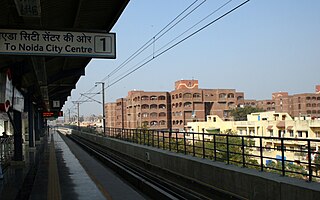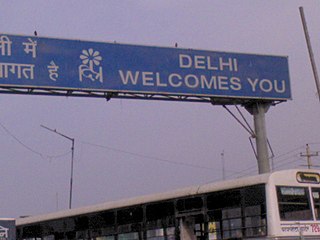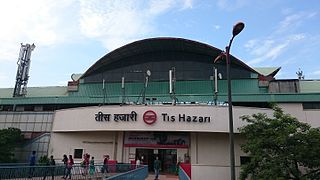The Dilshad Garden metro station is a station of the Red Line of the Delhi Metro. [1] It was the terminal station of the Red Line till 7 March 2019.
The Dilshad Garden metro station is a station of the Red Line of the Delhi Metro. [1] It was the terminal station of the Red Line till 7 March 2019.
| L2 | Side platform | Doors will open on the left | |
| Platform 2 Eastbound | Towards → Shaheed Sthal Next Station: Shaheed Nagar (Delhi-UP Border) | |
| Platform 1 Westbound | Towards ← Rithala Next Station: Jhilmil | |
| Side platform | Doors will open on the left | ||
| L1 | Concourse | Fare control, station agent, Metro Card vending machines, crossover |
| G | Street Level | Exit/Entrance |
The station has the following facilities: [2]
The Mudrika Seva is one of the most popular bus routes in Delhi, India. It was started by the Delhi Transport Corporation (DTC) in May 1974, and is now operated by both the Corporation and DIMTS' cluster buses. The service runs on Delhi's inner ring road, with major stops at AIIMS, Lajpat Nagar, Sarai Kale Khan, ITO, Delhi Gate, Kashmere Gate, DU North Campus, Model Town, Azadpur market, Shalimar Bagh, Punjabi Bagh, Britannia Factory, Rajouri Garden, Naraina, and DU South Campus.

Mayur Vihar is an upmarket residential area on the periphery of Delhi, located in East Delhi, close to the city's Noida-Delhi border, situated just across the Yamuna River, and is divided into three distinct phases (sectors). As the name suggests, it has been the dwelling (vihar) of peacocks (mayur). Even today, the area has a closed sanctuary dedicated to the conservation of peacocks.
Ramakrishna Puram popularly known as R.K. Puram, is a residential colony in Delhi. Named after the saint Sri Ramakrishna, it houses many high-profile corporate houses.

The Red Line is a rapid transit metro line of the Delhi Metro in Delhi, India. It is mostly an elevated line and has 29 stations that runs from Rithala to Shaheed Sthal with a total distance of 34.55 km. The Tis Hazari – Shahdara section of this line was the first stretch of the Delhi Metro that was constructed and commissioned. The line connects the areas of Ghaziabad in Uttar Pradesh and the districts of Shahdara, Central Delhi and North West Delhi in Delhi.

Delhi has significant reliance on its transport infrastructure. The city has developed a highly efficient public transport system with the introduction of the Delhi Metro, which is undergoing a rapid modernization and expansion since 2006. There are 16.6 million registered vehicles in the city as of 30 June 2014, which is the highest in the world among all cities, most of which do not follow any pollution emission norm, while the Delhi metropolitan region has 11.2 million vehicles. Delhi and NCR lose nearly 42 crore man-hours every month while commuting between home and office through public transport, due to the traffic congestion. Therefore, serious efforts, including a number of transport infrastructure projects, are under way to encourage usage of public transport in the city.

East Delhi is an administrative district of Delhi in India. It is bounded by the Yamuna River on the west, North East Delhi to the north, Ghaziabad District of Uttar Pradesh state to the east, and Gautam Buddha Nagar District of Uttar Pradesh to the south. Administratively, the district is divided into three subdivisions: Gandhi Nagar, Preet Vihar, and Mayur Vihar.
Dilshad Garden is a large housing colony located in East Delhi, which was primarily developed by Delhi Development Authority. The area Situated near Apsara border or Shahdara border within 0KM on fringe of Delhi which is one of the main border of Delhi which Separates Jurisdiction of NCT of Delhi and Uttar pradesh. Dilshad Garden falls under the both Shahdara and Seemapuri constituency of the legislative assembly. Thus, a part of Dilshad Garden falls under MLA of Seemapuri Vidhansabha Shri Rajender Pal Gautam and its other part falls under the MLA of Shahdara Vidhansabha Shri Ram Niwas Goyal.

Kapashera Border is one of the main Borders of Delhi. It connects Delhi to Gurugram district of Haryana state. The road connecting two said cities is referred to as Old Delhi-Gurgaon Road.
Vasundhara Enclave is a posh residential area located in East Delhi. The adjoining areas include Dallupura, Mayur Vihar, New Kondli and New Ashok Nagar. Vasundhara Enclave has about forty-four apartments.

Kashmere Gate, also known as Kashmiri Gate, is a key metro station on the Delhi Metro network. It features a unique design with an elevated structure for the Red Line and underground facilities for both the Yellow and Violet Lines. As a transfer station, it connects the Red Line at the highest upper level with the Yellow Line at the lowest underground level and the Violet Line on a parallel underground level, facilitating seamless inter-line connectivity.

The Tis Hazari metro station is a metro station located on the Red Line of Delhi Metro. It is situated in the Tis Hazari area of Central Delhi. The station is situated just across the road from the Tis Hazari Courts Complex, which is the principal district court of Delhi. It is connected to gate number 2 of the complex by a footbridge. The footbridge has a ramp available for the disabled or physically challenged people.

The Mayur Vihar Phase-1 metro station serves as an interchange station between the Blue Line and the Pink Line of Delhi Metro. This station, located in East Delhi, connects the Mayur Vihar area and is within walking distance of Mayur Vihar Pocket-I and Pocket-IV.

Anand Vihar is an interchange metro station located on the Blue and Pink lines of the Delhi Metro. Anand Vihar served as the terminus of the Blue line until July 13, 2011. The station is situated in the locality of Anand Vihar, near the interstate border between Delhi and Uttar Pradesh, and functions as a major connectivity hub for East Delhi. It is seamlessly integrated with the Anand Vihar ISBT and the Anand Vihar Terminal of Indian Railways. The upcoming RapidX station at Anand Vihar will further enhance connectivity, providing faster transit options to neighbouring cities and boosting intermodal transportation links in the region.

The Hauz Khas metro station is an interchange station between the Yellow Line and the Magenta Line of the Delhi Metro. It serves Hauz Khas Enclave, Sarvapriya Vihar, Vijay Mandal Enclave, RBI colony, Mayfair Gardens and the IIT Delhi. The entrance to the station is located on Outer Ring Road, to the east of Aurobindo Marg and to the west of Khelgaon Marg.

The Kalkaji Mandir metro station is an interchange station between the Violet Line and the Magenta Line of Delhi Metro. It serves the area of Kalkaji in South-East Delhi, and provides access to many tourist sites such as Kalkaji Mandir, Lotus Temple, Prachin Bhairav Mandir and ISKCON Temple. The station was opened along with the first section of the Violet Line from Central Secretariat - Sarita Vihar on 3 October 2010, in time for the Commonwealth Games opening ceremony on the same day. Its interchange with the Magenta Line was opened on 25 December 2017.

The Delhi Metro is a rapid transit system that serves Delhi and the adjoining satellite cities of Ghaziabad, Faridabad, Gurugram, Noida, Bahadurgarh, and Ballabhgarh in the National Capital Region of India. The system consists of 10 colour-coded lines serving 256 stations, with a total length of 350.42 kilometres (217.74 mi). It is India's largest and busiest metro rail system and the second-oldest, after the Kolkata Metro. The metro has a mix of underground, at-grade, and elevated stations using broad-gauge and standard-gauge tracks. The metro makes over 4,300 trips daily.
Mayur Vihar Phase-3 is the third phase of the Mayur Vihar residential area in East Delhi. It lies in Kondli constituency close to the Noida border on one side and New Kondli and Gharoli on the other. It lies adjacent to Vasundhara Enclave, another prominent residential area of East Delhi. It lies on the eastern border of Delhi and shares Border of Uttar Pradesh with Noida as well as Khora Colony, a cluster of urban settlements bordering Ghaziabad. The Pincode of this area is 110096.

The Pink Line is a metro rail line of the Delhi Metro, a rapid transit system in Delhi, India. It consists of 38 metro stations from Majlis Park to Shiv Vihar, both in North Delhi.

The Maharana Pratap Interstate Bus Terminus (Maharana Pratap ISBT), popularly known as Kashmere Gate Interstate Bus Terminus (Kashmere Gate ISBT), located in Delhi, is the oldest and one of the largest Inter-State Bus Terminals in India. It operates bus services between Delhi and the neighbouring states and union territories of Haryana, Jammu and Kashmir, Ladakh, Punjab, Himachal Pradesh, Uttar Pradesh, Rajasthan and Uttarakhand. Spanning about 5.3 acres, it handles over 1,800 buses a day.
Vivek Vihar is one of 3 subdivisions of Delhi's Shahdara district, near the edge of Ghaziabad as well as a small neighbourhood in that subdivision located beside just besides the Choudhary Charan Singh road along with Uttar Pradesh border.
Metro Feeder Buses - Routes